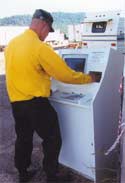Winter 2001
Computer Kiosks: New Feedback
By Rob Chaney
The Missoulian
After the Hells Angels Motorcycle Club paid a visit that sparked a near-riot in town last summer, The Missoulian had its first chance to test its latest idea for reaching out to the community – home-grown computer survey kiosks.

One kisok left near the clash site collected more than 30 comments in an hour, including many from eyewitnesses who were willing to sign their names for follow-up interviews.
“I witnessed the police club people. I also witnessed other police officers videotaping a lot of the events that occurred. They looked at the event like it was fun. It was absolutely disgusting,” wrote an Aug. 2 respondent.
The kiosks and their software weren’t completely debugged at the time. But they accurately forecast the depth of public anger. Seven months later, the community is completing a special review of police actions, particularly the use of pepper spray to break up crowds.
Just six months after we began using the computer kiosks to gather public reaction to various issues, we are pleased with the results. Although we assumed they would be most useful for political news, we discovered much wider applications.
During last summer’s fire season, we used them to collect comments from workers fighting Montana’s raging forest fires. “What’s the hardest part of serving at the camp?” we asked. Among the 50 printable responses was Army infantryman Steven Roy’s: “Sickness of the soldiers.” His comment sparked interest in medical care at the camps and a feature story for our Health Page.
The kiosks did perform well during the election season, but in an indirect way. They helped us identify issues people wanted local candidates to discuss and to see how different communities had different priorities.
In last year’s legislative races, kiosk surveys predicted stronger-than-expected interest in land-use rules among county voters. City voters were more focused on school funding. Both these indicators were backed up by audience questions at candidate forums.
Since August, when the kiosks became fully operational, I’ve used them six times, resulting in two features focused on survey opinions, four stories incorporating survey data and dozens of election pieces influenced by survey responses.
I’m now training other staff members and the Missoulian’s Newspaper in Education coordinator to use the kiosks. The goal is to have someone using them at least once a month.
How It All Began
The idea for the kiosks came after a Pew Center workshop in San Diego. The father of this project was a tourist information kiosk in our hotel. Its mother was “The Box,” a brainchild of producer Peggy Case at KCTS-TV in Seattle, who demonstrated how she used stationary videocameras to collect comments to a question posted on a TV screen.
Case’s portable television confessional booth intrigued us enough to wonder if we could adapt the idea for print. While convincing people to tell stories on camera is hard enough, getting them to write their thoughts seemed daunting. That’s where the tourist kiosk came in.
We had experimented with voter outreach pages on the Missoulian’s web site, where we could link an interactive city map to archives of candidate coverage. Users could choose their ward or voting precinct and learn what candidates or issues were on the ballot. Then they could follow links to candidate bios, resumes, photos and stories we’d published about their appearances or activities.
But in Montana, Internet access is somewhat limited. A stand-alone kiosk with copies of those web pages, however, could be taken to places where the Internet wasn’t, such as convention hall lobbies, school cafeterias, shopping centers, retirement homes – anywhere, really, that there was a power supply. No telephone would be needed.
Once there, we thought: Why not be able to ask users their thoughts on whatever issue prompted the outreach in the first place? So we built a survey program that would ask some questions users could fill out after learning about an issue.
Steep Learning Curve
With $5,000 in Pew Center funding, we embarked on our experiment. Little did we anticipate how much we’d learn about the software business.
After failing to find an off-the-shelf survey program that would do what we wanted, we commissioned one. The initial design was literally sketched on a cocktail napkin. The resulting program is relatively simple. But it took weeks of testing and debugging to reach a trustworthy performance level.
At first, we anticipated buying half a dozen lightly used computers for about $500 apiece. After talking with our software engineer about what performance level the program would require, I realized we could get away with government surplus machines costing only $90, terminal included.
If we really wanted to scrounge, we probably could have devised some “Frankenmachines” out of the obsolete or busted gear collecting dust in the Missoulian’s storage rooms. In fact, the experience has inspired our tech staff to do just that – only for other departments.
_____________________________
Chaney is putting his software survey program on a CD, available to other newsrooms, with an installation and user guide. To get a copy, e-mail the Pew Center: news@pccj.org.
